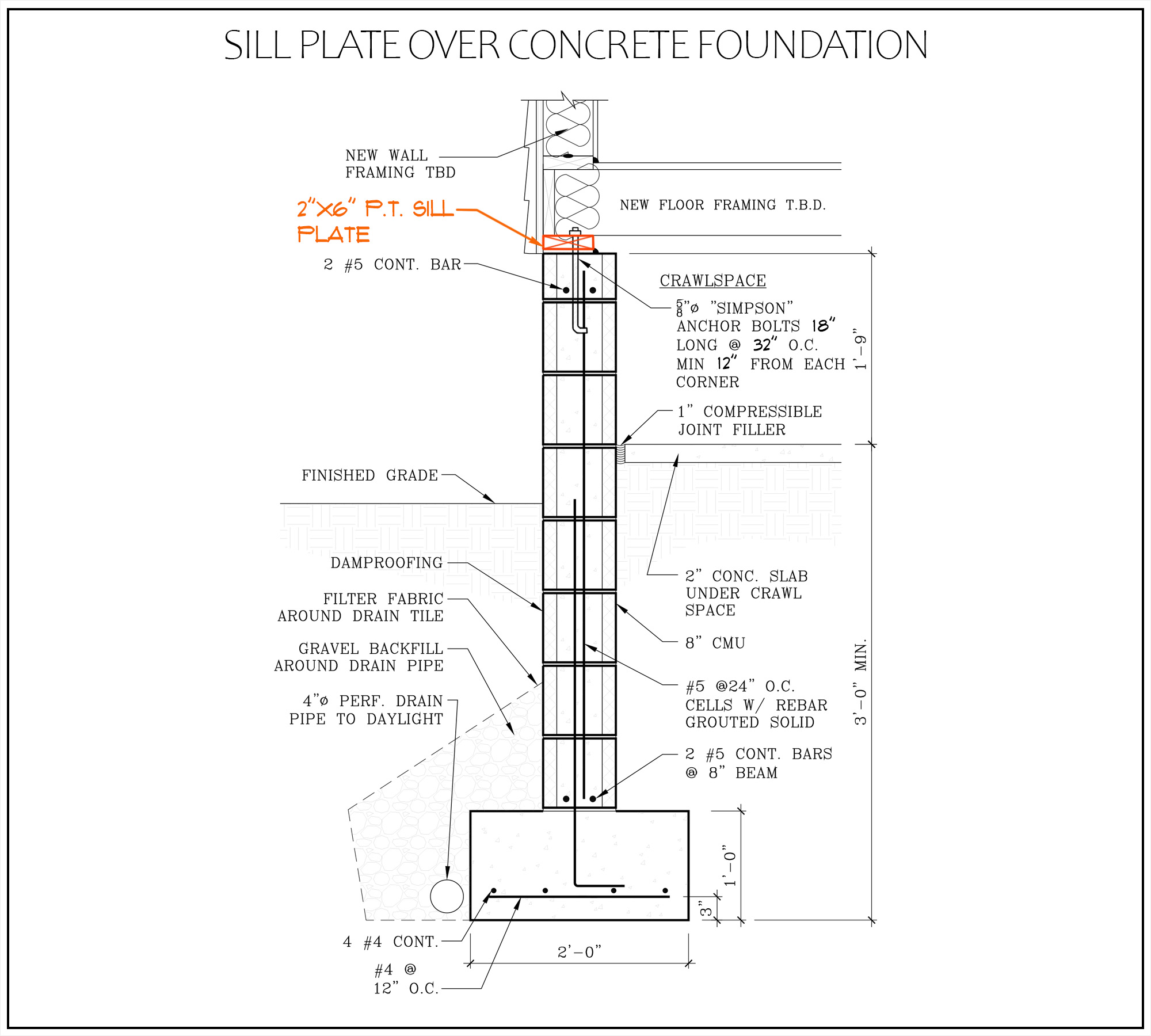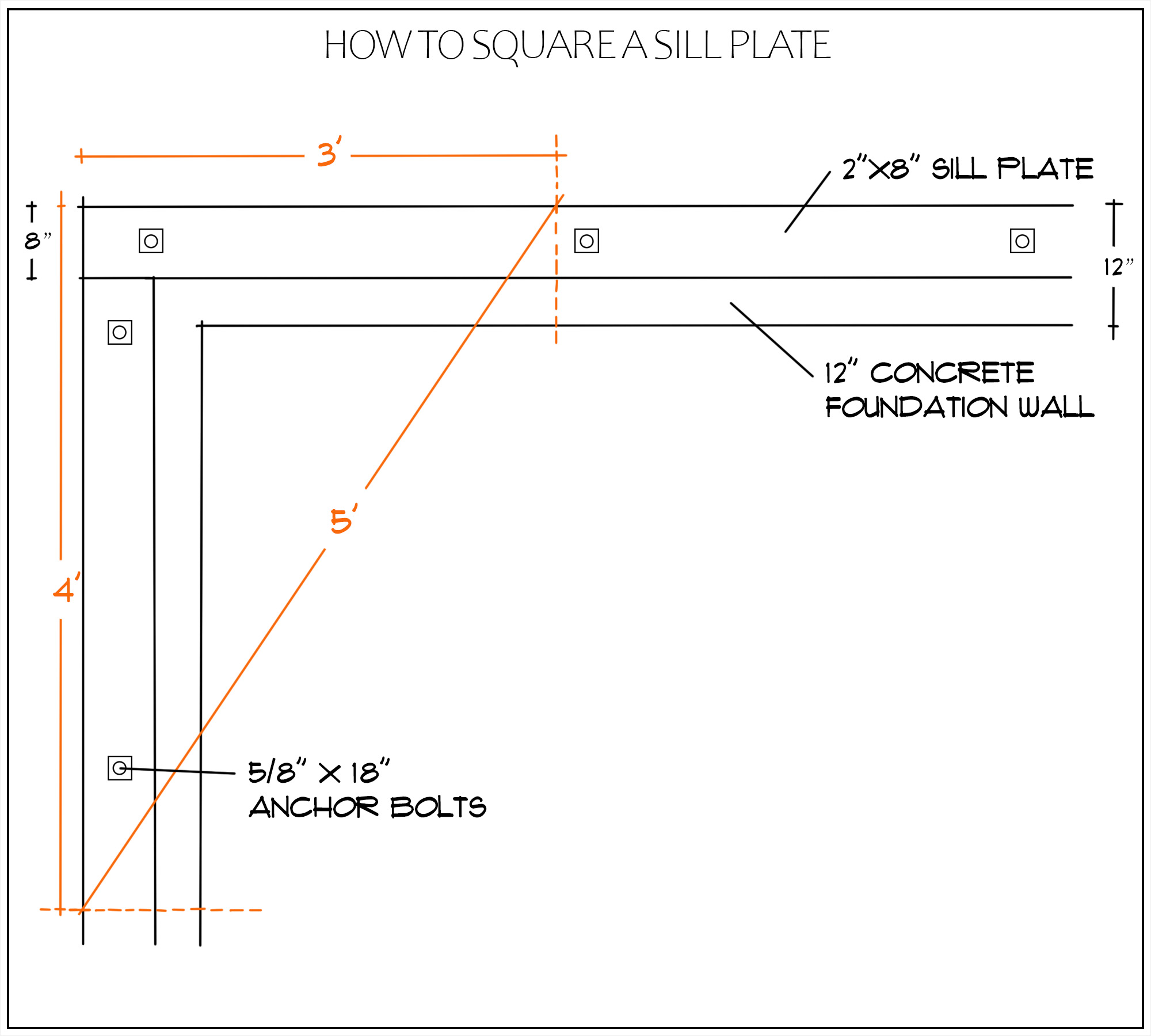What Is A Sill Plate?
A sill plate is a wood board that connects the frame of a house to its foundation. Anchor bolts are inserted into the foundation when the concrete is still wet. The bolts run through the sill plate and are tightly bolted down with nuts and washers. When fully tightened, the bolts anchor the plate to the foundation. Once the sill plates are installed and bolted down, the rest of your house is framed on top of the plates. A sill plate is one of the most important parts of a house’s frame because it’s what ties the foundation and frame together. Without a sill plate, the frame of a house would be simply sitting on top of the foundation and not actually connected to it. This would be very dangerous in a wind storm or earthquake.
Securing a home’s frame to its foundation is a very important part of building a strong house. It’s also an area that water and air can penetrate. To fix this we also install a thin layer of insulation between the plate and concrete. This is called sill seal insulation. It helps insulate a home and keep it dry.
Sill plates are also called a mud sill. When you frame a house, the first pieces of wood you install are the sill plates. Everything else is built on top. You can actually see the plate from inside your basement or crawl space. If you look on top of your foundation wall, the piece of wood sitting between the floor joists and concrete is the sill plate.
You can’t see the plate from the outside because it’s covered by the wall sheathing and siding.
What Is The Purpose Of A Sill Plate?
The primary purpose of a sill plate is to connect the frame of a house to its foundation. The sill plate is bolted to the foundation and the house’s floor joists nailed to the plate. The entire home is secured to the foundation through the plate. Without it, a house would sit on top its foundation but wouldn’t be anchored to it.
A sill plate creates a flat, even surface for the house to be built on. Once the plate is bolted down, floor joists are installed on top. To build a flat and even floor, you need the joists to be at the same height across the entire floor span. This is made possible by a flat and even plate.
A sill plate spreads the weight of the house evenly across the foundation. If you laid floor joists directly on top of the concrete, the home’s weight would push down onto the foundation only where each joist touched the concrete. But no weight would be in the spaces between the joists. This is a very uneven load with lots of weight in small areas. By using a sill plate, weight is distributed evenly across the entire foundation.
A sill plate also helps insulate and waterproof a home. Masonry tends to absorb water which can be transferred into the wood that sits on top it. That moisture could then work it’s way into the home and cause rot. To prevent this, sill plates are made from treated wood. They’re also insulated with a layer of sill seal insulation which further prevents water and air infiltration.
Sill Plates Are An Important Part Of A House’s Frame
The sill plate is a wood board, usually 2 x 4 or larger, laid face down on top of the foundation wall. Because masonry soaks up so much moisture, sill plates are generally made of treated lumber which resists rot.
The sill plate runs along the entire foundation to create a perimeter of wood. Sill plates are bolted to the foundation with anchor bolts and nailed to each other which forms a single continuous piece of wood.
The first floor frame is built on top of the sill plate. A home’s floor frame consists of common joists which span across the foundation walls, and band or rim joists that cover the ends of the common joists. Band joists and rim joists are installed flush with the outside edges of the sill plate.
Floor joists are covered with a plywood sub-flooring to complete the floor frame. The first floor walls are framed on top of the sub-flooring.
A sill plate connects a home’s wood framing to its masonry foundation. It’s a buffer that secures two different materials together.
How To Install A Sill Plate
When a home’s foundation is being built, heavy-duty steel anchor bolts, called J-bolts, are set into the wet concrete.
J-bolts have a bend at the bottom that locks the bolt into the concrete after it hardens. The top of the bolts are threaded and extend about 6 inches above the concrete. Once the foundation is done, carpenters start installing the sill plates.
A hole is drilled through each sill plate so the J-bolt can pass through it. This allows the wood to sit directly on top of the concrete. The sill plates are then anchored to the foundation with large washers and nuts threaded onto the J-bolts.
Thin rolled insulation, called sill seal, is usually placed between the wood and foundation as it’s being installed. This extra layer of protection helps prevent moisture and air penetration and rot.
Homes built in termite prone areas often have a metal barrier installed under the sill plate. This metal layer helps stop insects from climbing up the wall and into the wood.
If the concrete was poured evenly, the sill plate can be laid directly onto the concrete. However, if the concrete is uneven, shims may be needed under the plate to level it. The top of the concrete can also be cut or ground down to create a level surface. This step is very important because the sill plates must be laid perfectly level. The entire house is built on top of them. If the plates are not installed level you’ll have big problems leveling the walls and floors later.
Installing A Sill Plate Step By Step
Here’s a step by step breakdown of how we install a sill plate:
- The plate is anchored to the foundation with anchor bolts called J-bolts. They’re large galvanized steel bolts with either a hook or expansion wedge at one end and threading for a nut at the other. These bolts are inserted into the foundation when the concrete is still wet.
- A hole is drilled into the sill plate to match each bolt. When the plate is laid on top the foundation, the threaded end of the anchor bolts pass through the holes.
- A thin layer of insulation, called sill seal, is usually installed in between the wood and concrete. Metal can also be used which helps prevent termite damage.
- Washers and nuts are screwed onto the threaded ends of the bolts. This holds the wood plate tightly to the concrete foundation.
It’s important to make sure the plates are perfectly square and level as you tighten them down. Floor joists, plywood sub-flooring, and walls will be built directly on top of the plates. If the sill plates are not level and square, the floors and walls won’t be either.
How To Check If Sill Plates Are Square And Level
Checking to make sure your sill plates are level is easy. All you need is a level. If the plates aren’t level, your foundation probably isn’t either. You can either fix the foundation or use wood shims to adjust the plate. This is a judgement call you’ll have to make on site. I generally prefer to fix the foundation if I can but have had success using shims.
The problem with shims is that they leave gaps in areas that don’t have shims. Fix this with insulating caulk or expandable foam.
Checking to make sure your plates are square is a little harder. I use the 3, 4, 5 method. Reference the illustration shown above.
- Measure in from the corner on the first plate 3′ and make a mark.
- Then measure the second plate in from the corner and make a mark at 4′.
- Finally measure between the two marks you just made on the plates. They should be exactly 5′ apart. If the measurement is less than 5′ your plates are are at an angle too sharp. They need to be pushed out a bit. If the measurement is over 5′ then the plates are too wide and need to be pulled in.
A second way to check for square is using a framing square. However this works better in tight spaces and not so much in large rooms.
You can expand the 3, 4, 5 method for any size room by doubling the numbers. Use 6, 8, 10 for medium size rooms and 12, 16, 20 for large rooms.
Anchor Bolts
If you want to install a sill plate correctly it’s important to understand a little bit about anchor bolts. They’re what secures the Sill plate to the foundation. If your home isn’t anchored to the foundation properly it could fail during a storm or earthquake.
Which anchor bolt you need will generally be marked on your foundation blueprint in a cross section detail. This is a drawing shown from the side view of a foundation wall.
The location of each bolt is usually shown on the top view foundation drawing.
In almost every home we build, the anchor bolts are 5/8th inch J-bolts made from galvanized steel. The washers are square with a 5/8″ galvanized nut. Bolts are 18″ long and stick up about 4″ from the top of the foundation wall. This leaves the bolts about 14″ in the concrete.
Bolts are generally places within 12 inches from each corner. From there, we install them about 32″ on center from each other along the wall. As you place the bolts be aware of where floor joists will be installed. You don’t want to accidentally put a bolt directly where a joist will fall.
Once the plates are installed, tighten the nuts over a square washer firmly.
How To Protect Your Sill Plates
Most houses have a sill sealer made of polyethylene foam that sits between the sill plate and the foundation. This prevents moisture from coming through the concrete which can rot the sill plate. Caulks and expandable spray foam can also be used to seal gaps and cracks. This helps insulate a basement or crawl space, prevent moisture penetration and rot, and helps keep insects out.
A layer of metal can also be installed on top of the foundation between the concrete and wood. This helps keep insects from getting into the wood.
To help protect a sill plate from the outside, wall sheathing is installed to the bottom of the plate. A house wrap like Tyvek and siding are then installed over the sheathing. All these layers cover and protect the plate from the elements.
Sill plates are usually made from pressure treated lumber to prevent damage from insects and moisture. Pressure treated wood has been placed in a tank, depressurized, and then re-pressurized with a preservative chemical. This thoroughly pushes the preservative into the wood.
Historically, chromated copper arsenate (CCA) was the most common preservative chemical used to treat lumber. However, CCA is toxic and has almost entirely been replaced with less toxic alternatives.
Older buildings that already have CCA-treated sill plates are still considered safe to live in.
What Is A Sill Plate Made Of
These days, almost all sill plates are made of pressure-treated wood. Pressure treatment protects the wood from moisture due to contact with masonry materials or from outdoor exposure. The wood is typically a standard lumber such as 2×4, 2×6, 2×8, 2×10, or 2×12.
Some sill plates are made from treated engineered lumber. Weyerhaeuser makes the sill plate we most often use. It’s called Timberstrand LSL. Engineered sill plates are long and super straight so carpenters don’t have to waste time culling the wood. Standard lumber sill plates aren’t usually the straightest wood so you have to spend time picking the best pieces and checking the wood as you go. With engineered wood you can skip a lot of these steps. However they’re about 3 times as expensive.
The wood treatment also includes insect an repellent which helps protect the wood from termites and other wood boring insects.
Because treatment chemicals are corrosive to some metals, fasteners and anchors that contact the sill plate material must be rated for pressure treated wood. Generally we use stainless steel or galvanized screws, nails, bolts, hangers, anchors, etc.
What Are Sill Plates Called
Sill plates are also called mud-sills, sills or plates. This can cause some confusion because other framing parts are called similar names.
- The bottom plate of a typical wall frame is installed face-down just like a sill plate. This is block of wood is often incorrectly refereed to as a sill plate but it’s actually called a sole plate. But it’s easy to spot the difference. A sill plate is installed on the concrete foundation but a sole plate is on the bottom of a wall.
- Window frames also have a sill. This is the horizontal piece of wood that defines the bottom of the rough opening. It’s on this block that the window is installed. This sill is sometimes also called a sill plate but it’s actually a window sill. Not a sill plate.
- Exteriors doors have a sill on the bottom too. But not a sill plate. A door sill is there to seal the door from the exterior.
Many homes don’t have a crawl space or basement. They have a different type of foundation called slab-on-grade. With this design, the first floor of the house is a concrete slab instead of a wood-framed platform.
With a slab-on-grade foundation, the first floor walls are built directly on top of the slab or on short foundation walls surrounding the slab. The bottom plates of these walls are actually the sill plates and are anchored to the foundation with bolts. In this case, it’s not be incorrect to call the wall’s bottom plate as a sill plate.
When you hear or read the word sill plate make sure they’re using the correct terms and referring to a foundation sill plate.
Timber Framing Sills
When using timber-frame construction, the sill plates are often called sills or sill beams. They’re heavy timbers that are notched to receive the vertical wall posts as well as the floor beams or joists. This type of framing isn’t used that often to build residential home or buildings. Although it’s still used to build some rural style homes like timber cabins or barns.
Timber frame sills are strong rigid beams which play a more structural role than a modern sill plate. They often rely more on their own strength to support the building in addition to the foundation.
Timber sills can lie on top of a stone or masonry foundation or even directly on the soil, although this leads to premature rot. As with other types of sills, it’s best to use some sort of anchor which secures the sill to its foundation.
Is A Sill Plate Necessary?
A sill plate is a necessary part of any building’s structure because it creates an even and flat surface on which to build the framing and ties the frame to its foundation. Without a sill plate, a home would sit on top of its foundation rather than being connected to it. As you can imagine, this would create a very weak and unstable home. You should never build a home without a sill plate.
Another very important thing a sill plate does is spreading the weight of a house evenly over the foundation. If you didn’t have a sill plate, the floor joists would rest directly on the foundation. The weight of the house would transfer to the joists and down to the foundation. Weight would press down wherever the joist touched the foundation, but not in all the space between the joists. This is a very bad way to frame. A sill plate transfers the weight evenly onto the foundation which makes the home stronger and more secure.
Sill plates also help protect the house against pests, air and moisture penetration. They sit directly on top of the foundation and are bolted down tight. Usually with some sort of insulation between the plate and concrete. This creates a tight seal which is hard to penetrate.
Is A Sill Plate Structural?
A sill plate is one of the most important parts of a house’s structural framing. The sill plate is generally the first piece of wood installed in the entire house frame.
The sill plate anchors a house’s frame to its foundation. Without it, a house would simply sit on top of its foundation rather than being connected to it. This would create a very weak and unstable home.
There are many parts that anchor a home to its foundation such as straps, bolts, anchors, tie downs and plywood. All of these elements work from the top of the house down to its foundation and through the sill plate.
The sill plate is generally the lowest piece of wood on a home’s frame which ties the masonry foundation and wood frame together. So yes, a sill plate is definitely structural.
What Goes Under A Sill Plate?
A thin continuous layer of 1/4-inch thick foam insulation called sill seal, is laid between the sill plate and foundation. This is also called a gasket or a moisture and air barrier.
This thin layer of insulation comes in a roll of different thicknesses. Use the thickness that matches the size of your plate. For example, if your sill plate is 2×4, use a 4″ wide gasket. It’s rolled out and installed on top of the concrete slab before installing the sill plates.
The gasket must be designed specifically for use with sill plates. Don’t buy just any type of foam because it may not last.
When the sill plate is bolted down it compresses the gasket. This seals any small gaps or cracks that may exist.
Summary: What Is A Sill Plate?
A sill plate is a wood board that connects the frame of a house to its foundation. Anchor bolts are inserted into the foundation when the concrete is still wet. The bolts run through the sill plate and are tightly bolted down with nuts and washers. When fully tightened, the bolts anchor the plate to the foundation. Once the sill plates are installed and bolted down, the rest of your house is framed on top of the plates. A sill plate is one of the most important parts of a house’s frame because it’s what ties the foundation and frame together. Without a sill plate, the frame of a house would be simply sitting on top of the foundation and not actually connected to it. This would be very dangerous in a wind storm or earthquake.
Securing a home’s frame to its foundation is a very important part of building a strong house. It’s also an area that water and air can penetrate. To fix this we also install a thin layer of insulation between the plate and concrete. This is called sill seal insulation. It helps insulate a home and keep it dry.
Sill plates are also called a mud sill. When you frame a house, the first pieces of wood you install are the sill plates. Everything else is built on top. You can actually see the plate from inside your basement or crawl space. If you look on top of your foundation wall, the piece of wood sitting between the floor joists and concrete is the sill plate.
You can’t see the plate from the outside because it’s covered by the wall sheathing and siding.
If you have any questions or comments, email any time.






















